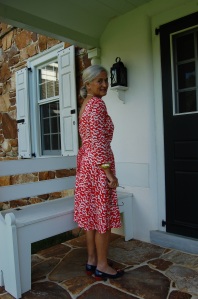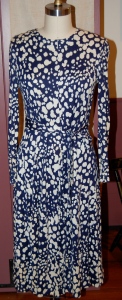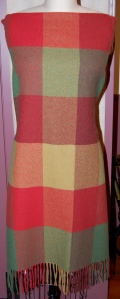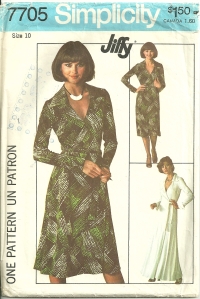The last thing I need is more fabric for Spring and Summer dresses, but try telling that to my rational side. She doesn’t listen. So last Fall, when I saw a cotton sateen in a large navy, orange and white floral print in the Etsy Store of Promenade Fabrics, and it was the last yardage on the bolt, I decided I had better act fast and put it in my “cart.” I certainly was not disappointed when it arrived, as it was beautiful quality, with a slight stretch to it, and the colors were just as dramatic as I had hoped they would be.
Fast forward to a few weeks ago, and I was scratching my head as to what pattern to use for it After washing and drying the fabric, I had about 1 5/8 yards. Fortunately it was 54” wide. I originally thought I would make a shirtdress with three-quarter sleeves, but I quickly determined I did not have enough yardage for that. Then I thought about a skirt, but that did not excite me too much. I kept coming back to the idea of a sleeveless wrap dress, and enough yardage or not, I was determined to try to make it work. I pulled out this pattern which I had made a few years ago (and it is still one of my favorite dresses to wear.)

The Simplicity “version” of the Diane von Furstenberg wrap dress. Obviously, I intended to make this sleeveless.
I had a very workable muslin for it, and as this particular wrap dress pattern is for woven, not knit, fabrics, I knew it would be appropriate. I also knew I was going to have to be creative in my layout. I almost always cut things out single layer, and of course, positioning your pattern on a single layer of fabric gives you much more flexibility and what I call “wiggle room.” Also to my advantage was the fact that there was no right side up for this fabric, so I could arrange the pieces upright or down, without regard to the design on the print. After much head-scratching and many calculations, I made a list of the changes I needed to make, thus solving the mystery of whether I could, indeed, make a wrap dress out of this fabric:
1) reduce the flare of the skirt by about 9 inches.
2) eliminate the facings and, instead, line the bodice.
3) forego pockets, which were not original to the pattern anyway
and the big concession, 4) reduce the length of the sashes by about 8 inches AND make the sashes with one side in the fashion fabric and one side in a dark navy blue cotton broadcloth (which I happened to have in my fabric closet, fortuitously!)
Fortunately, I was able to fit the collar pieces in! Here’s what my pattern layout looked like:
Back to my story – with my fabric all cut and ready to sew, one would think this dress would speed right along. And it would have, except that about this time we were getting our porch furniture out of storage in our garage. I had forgotten that our porch cushions and pillows had looked so awful last year that I didn’t even want to use them. This was the year I needed to do a major home sewing job and recover those cushions and pillows. So that’s what I did. By the time I got back to my wrap dress, my momentum was definitely lacking speed, and then the mystery was just how I was going to get excited about completing it!
I have to say the only thing which kept me focused on finishing this dress was the fact that I have so many other projects in my queue. Now that it is finished, I am so glad I pushed through!
One thing that is not a mystery – I think I am finished with making wrap dresses for a while!




























































































